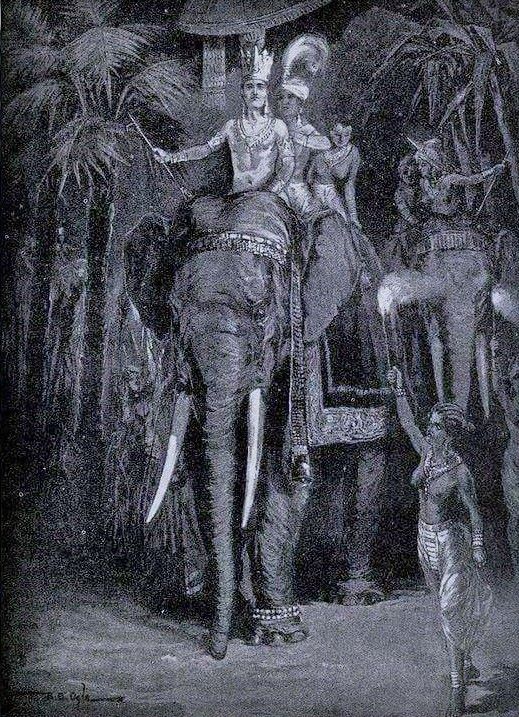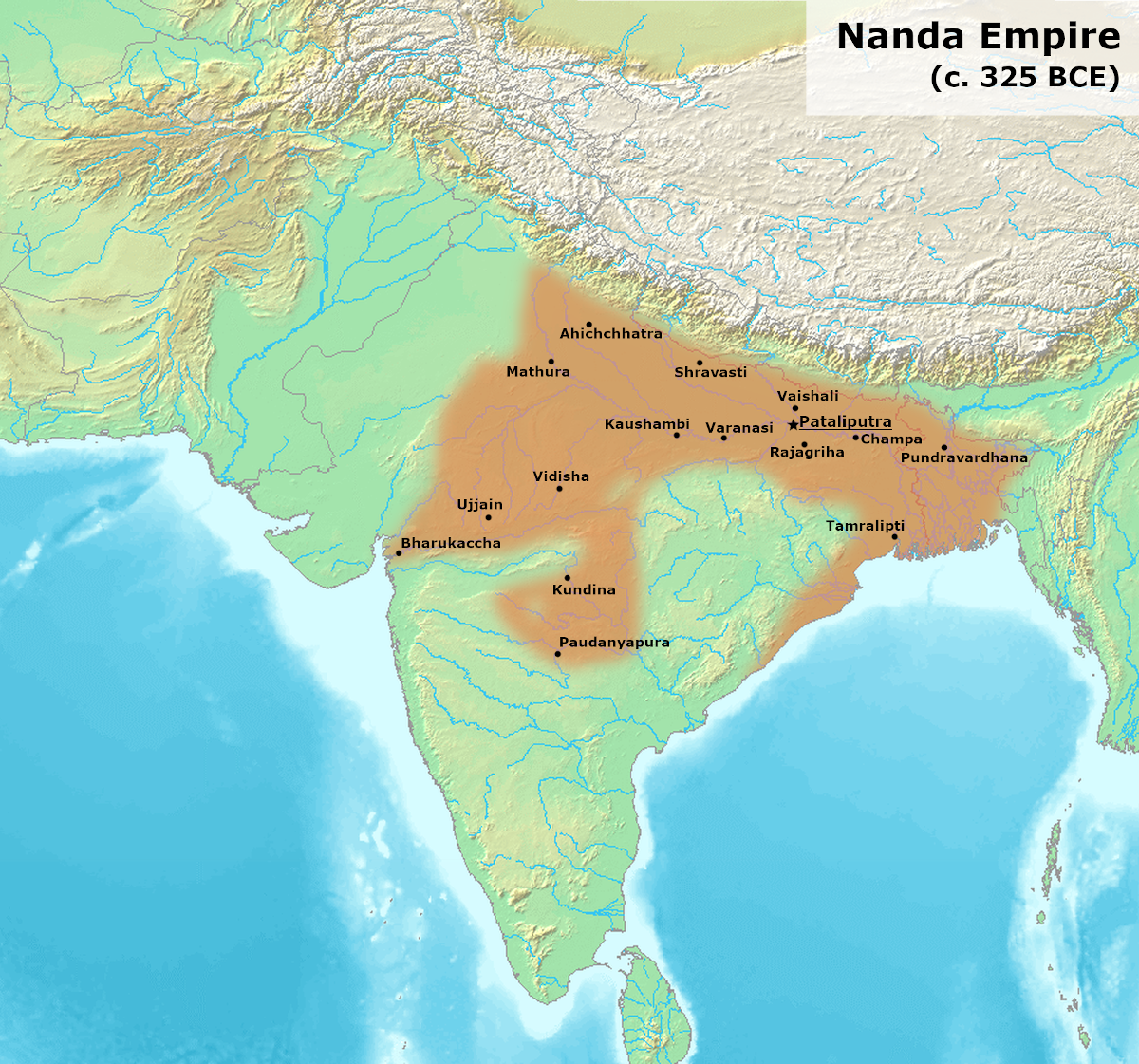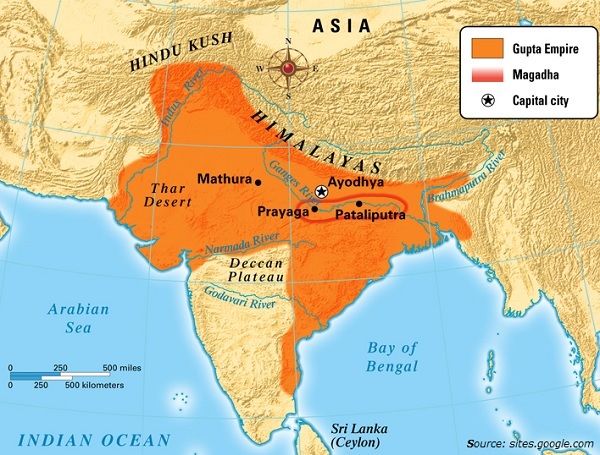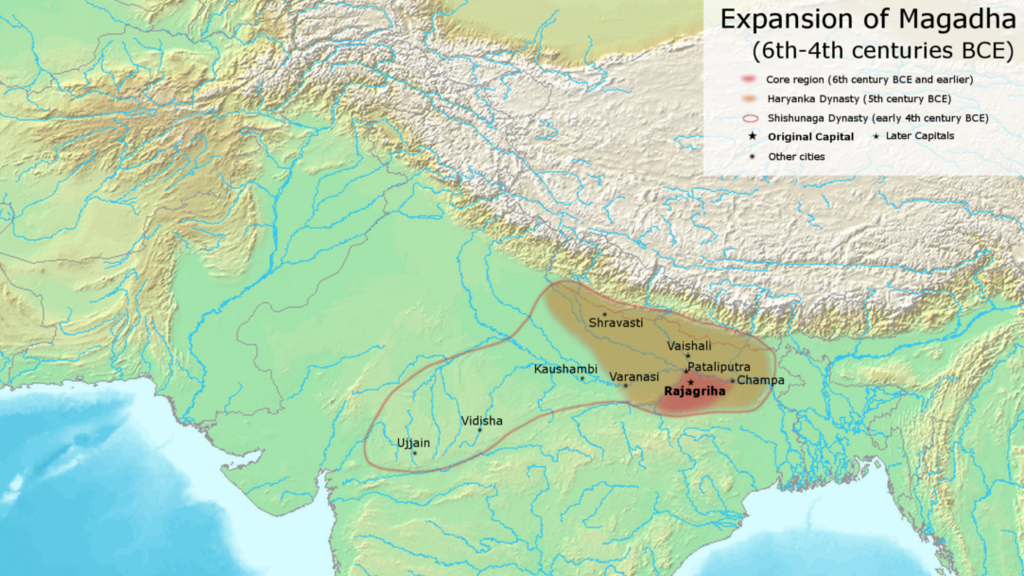More than eight dynasties ruled over Magadha for many centuries. Starting from Brihadratha to the Imperial Gupta dynasty had ruled over the reign and raised Magadha to one of the most prominent reigns in the ancient history of India.
Dynasties: Brihadratha Dynasty, Pradyota Dynasty, Haryanka Dynasty Śiśunāga Dynasty (c. 684-424 B.C.E.), Nanda Dynasty, Maurya Dynasty, Sunga Dynasty, Kanva Dynasty, Gupta Dynasty. Among the sixteen Mahajanapadas, Magadha rose to prominence under several dynasties that peaked with the reign of Asoka Maurya, one of India’s most legendary and famous emperors.
Brihadratha Dynasty
According to the Puranas, the Brihadratha Dynasty, the sixth in line from Emperor Kuru of the Bharata dynasty through his eldest son established the Magadha Empire. Emperor Brihadratha stood as the first prominent Emperor of the Magadha branch of Bharat has.
Pradyota Dynasty
The Pradyotas, who according to the Vayu Purana ruled for 138 years, succeeded the Brihadrathas. One of the Pradyota traditions was for the prince to kill his father to become king. During that time, high crimes reportedly took place in Magadha. The people rose and elected Shishunag to become the new king, which destroyed the power of the Pradyotas and created the Shishunag dynasty.
Haryanka Dynasty
The Haryanka dynasty founded the Magadha Empire in 684 BC, whose capital was Rajagriha, later Pataliputra. This dynasty was succeeded by the Shishunaga dynasty.
The Mahajanapadas of Anga, Kashi, Kosala, Chedi, Vatsa, Matsya, Shursen, Ashmak, Avanti, Gandhar, and Magadha was ruled by kings or monarchs. The kings in these states had the supreme authority. The Mahajanapadas of Vrijji, Malla, Kuru, Panchal, and Kamboj were republican states and so were other smaller states like Lichhavi, Shakya, Kolya, Bhagga, Moriya. These republican states had a ‘Gana-Parishad’ or an Assembly of senior and responsible citizens. This Gana-Parishad had the supreme authority in the state. All the administrative decisions were taken by this Parishad. Of all these states, Kosala, Vatsa, Avanti, and Magadha were the most important ones.
Bimbisara

Bimbisara (558-491 B.C.), the greatest patron of Gautama Buddha, was one of the early kings of the ancient Indian kingdom of Magadha. He extended his kingdom up to Anga in the East and this expansion is considered to have laid the foundation for the vast expansion of the Maurya Empire in the future. He was only fifteen when he became the king and he ruled for fifty-two years.
His wife was a princess of Kosala, who brought Bimbisara the village of Kashi as dowry and also bore him his son Ajathshatru. Among his other wives, there were Khema, Silva, Jayasena, and Chellana. The latter was a Lichchavi princess from Vaishali. Bimbisara used marriage alliances to strengthen his position. He had another son, Vimala Kondanna, by the famous courtesan, Ambapali.
In the Pabbaja Sutta of the Sutta Nipatta Atthakatha, it is stated that he saw Goutam Budhha for the first time through his palace window, under the Pandava Pabbata. Bimbisara invited him to visit his court but Budhha refused as he was in search of Enlightenment. The king wished him luck and requested him to visit Rajgir as soon as he would receive Enlightenment. Later Budhha visited Rajgir to fulfill the promise he made to Bimbisara.
Bimbisara became a serious disciple of Goutam Budhha and continued to patronize Buddhism for the rest of his life.
Ajatshatru

He was the son of Bimbisara. It is believed that he had killed his father to seize the throne. Ajatshatru was a great king, the first Emperor of Northern India who had defeated most of his neighboring states. He is also credited for innovation in military technology in warfare against the Licchavis. Although he was harsh towards his father, he is said to be humble towards his subjects (citizens). He was a great warrior as well as a notable scholar.
But the most important thing is that Ajatshatru has been provided a special place in all important religions of Ancient India, be it Hinduism or Buddhism or Jainism. An extremely rare position, which no king or emperor enjoyed afterward. In the Buddhist texts, he is shown as a Buddhist; in Jain texts, he seems to be a Jain and in the Brihadaranyak Upanishad, he is portrayed as a Vedic follower. Ajatshatru was a great scholar and a secular king.
Udayin
King Udayin was a ruler of the Haryanka dynasty who ruled over Magadha from 460 BCE to 440 BCE. He was the son of Ajatashatru and grandson of King Bimbisara. Udayin laid the foundation of the city of Pataliputra at the confluence of the two rivers, the Son and the Ganges. He shifted his capital from Rajgriha to Patliputra because of the latter’s central location in the Magadha empire.
Shishunag Dynasty
According to tradition, the Shishunag dynasty founded the Magadha Empire in 684 B.C.E., with its capital in Rajagriha, later Patliputra, near the present-day Patna. That dynasty lasted till 424 B.C.E. when the Nanda dynasty overthrew it. That period saw the development of two of India’s major religions that started from Magadha. Gautama Buddha in the sixth or fifth century B.C.E. founded Buddhism, which later spread to East Asia and South-East Asia, while Mahavira revived and propagated the ancient Brahmanic religion of Jainism.
Shishunaga
Shishunaga founded his dynasty in 413 BCE with its capital in Rajgir and later Patliputra. Buddhist sources indicate that he had a secondary capital at Vaishali, formerly the capital of Vajji, until it was conquered by Magadha. The Shishunaga dynasty ruled one of the largest empires in the Indian subcontinent. The most important achievement of Shishunaga was the destruction of the Pradyota dynasty of Avanti. This brought to an end the hundred-year-old rivalry between Magadha and Avanti from then Avanti became a part of Magadha rule
Kalashoka
According to the Puranas, Shishunaga was succeeded by his son Kalashoka and according to the Sinhala chronicles by his son Kalashoka. Based on the evidence of the Ashokavadana, Hermann Jacobi, Wilhelm Geiger, and Ramakrishna Gopal Bhandarkar concluded that both are the same. During Shishunaga’s reign, he was the governor of Varanasi. The two most significant events of his reign are the Second Buddhist council at Vaishali in 383 BC and the final transfer of the capital to Pataliputra. According to the Harshacharita, he was killed by a dagger thrust into his throat in the vicinity of his capital. According to Buddhist tradition, he had nine or ten sons, who were ousted by Ugrasena Nanda.
Nanda Dynasty

The Nanda dynasty was established by an illegitimate son of the king Mahanandin of the previous Shishunag dynasty. Mahapadma Nanda died at the age of 88, ruling the bulk of this 100-year dynasty. The Nandas were followed by the Maurya dynasty.
Maurya Dynasty

In 321 B.C.E., exiled general Chandragupta Maurya founded the Maurya dynasty after overthrowing the reigning Nanda king Dhana Nanda to establish the Maurya Empire. During that time, most of the subcontinent united under a single government for the first time. Capitalizing on the destabilization of northern India by the Persian and Greek incursions, the Mauryan Empire under Chandragupta not only conquered most of the Indian subcontinent but also pushed its boundaries into Persia and Central Asia, conquering the Gandhara region. Chandragupta was succeeded by his son Bindusara, who expanded the kingdom over most of present-day India, barring the extreme south and east.
Only present-day Tamil Nadu and Kerala (a Tamil kingdom then) fell outside the rule of the Mauryans. References exist in one of the oldest Tamil Sangam literature, Purananuru that a unified Tamil army under the leadership of Ilanchetchenni, a Chola King drove out a Mauryan army. According to one of his inscriptions, King Kharavela, a Kalinga ruler, defeated that unified Tamil force. His son, Ashoka the Great, who initially sought to expand the kingdom, inherited the kingdom.
In the aftermath of the carnage caused in the invasion of Kalinga, he renounced bloodshed and pursued a policy of non-violence or ahimsa after converting to Buddhism. The Edicts of Ashoka constitute the oldest preserved historical documents of India, and from Ashoka’s time, approximate dating of dynasties became possible. The Mauryan dynasty under Ashoka spread Buddhist ideals across the whole of East Asia and South-East Asia, fundamentally altering the history and development of Asia as a whole. Ashoka the Great has been described as one of the greatest rulers the world has seen.
Sunga Dynasty

The Sunga dynasty was established in 185 B.C.E. about fifty years after Asoka’s death. The commander-in-chief of the Mauryan armed forces, Pushymitra Sunga, assassinated king Brihadratha, the last of the Mauryan rulers, while he took the Guard of Honor of his forces. Pushymitra Sunga then ascended the throne.
Kanva Dynasty
The Kanva dynasty replaced the Sunga dynasty, and ruled in the eastern part of India from 71 B.C.E. to 26 B.C.E. Vasudeva of the Kanva dynasty overthrew the last ruler of the Sunga dynasty in 75 B.C.E. The Kanva ruler allowed the kings of the Sunga dynasty to continue to rule in obscurity in a corner of their former dominions. Four Kanva rulers ruled Magadha. In 30 B.C.E., the southern power swept away both the Kanvas and Sungas absorbing the province of Eastern Malwa. Following the collapse of the Kanva dynasty, the Satavahana dynasty of the Andhra kingdom replaced the Magadhan kingdom as the most powerful Indian state.
Gupta Dynasty

The Gupta dynasty, ruling from 240 to 550 C.E., had been one of the largest political and military empires in ancient India. Most historians refer to the Gupta age as the Classical age of India. The time of the Gupta Empire proved an Indian “Golden Age” in science, mathematics, astronomy, religion, and philosophy.
They had their capital at Patliputra. The Gupta and Mauryan administrative structure differed. In the Mauryan administration power centralized while in the Gupta administration, power decentralized. The king occupied a powerful and important position and often took titles to assert his supremacy. A council of ministers and some officials helped him. The empire divided into provinces, with the provinces further divided into districts. Villages represented the smallest units. The kingdom covered Gujarat, northeast India, south-eastern Pakistan, Orissa, northern Madhya Pradesh, and eastern India.
Art and architecture flourished during the Gupta age. People, mostly Vaishnavas, built temples devoted to Shiva and Vishnu during that period. Early temples had a large room where the statue of the god stood. Today those exist in Deogarh in Jhansi. Temples were mostly made of brick or stone. The doorways were very decorative. Murals flourished during that age. These can be seen in Ajanta caves which are about 100 kilometers from Aurangabad. Those murals depict the life of Buddha. Brahmins performed Yajna. All forms of worship were carried out in Sanskrit. Astronomy and mathematics made rapid strides, led by Aryabhatta and Varahamihira. Aryabhatta stated that the earth moved around the sun and rotated on its own Axis.
The Iron Pillar near Mehrauli on the outskirts of Delhi provides proof. Ayurveda was known to the people of Gupta age. Prosperity and contentment had been the order of the day. Most people lived in villages and led a simple life. Rest houses and hospitals were set up. Laws were simple and punishments lenient. A serious flaw existed. They were made to live outside the city, even their shadows considered polluting. Kalidasa’s works (that is, Raghuvamsa, Meghdoot, Malavikagnimitram, and Abhinjnana Shakuntalam), works of Fa-Hein, the Chinese Buddhist scholar, Allahabad pillar inscription called Prayag Prashasti, and books by Harisena constitute The sources for knowledge during that era.

